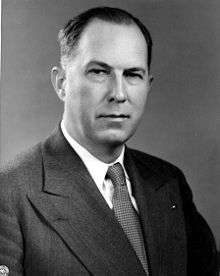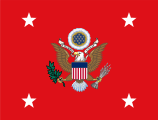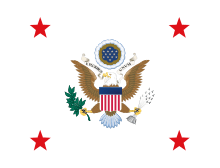Kenneth Claiborne Royall
| Kenneth C. Royall | |
|---|---|
 | |
| 56th United States Secretary of War | |
|
In office July 19, 1947 – September 18, 1947 | |
| President | Harry S. Truman |
| Preceded by | Robert P. Patterson |
| Succeeded by | Position abolished (Secretary of the Army) |
| 1st United States Secretary of the Army | |
|
In office September 18, 1947 – April 27, 1949 | |
| President | Harry S. Truman |
| Preceded by | Position established |
| Succeeded by | Gordon Gray |
| Personal details | |
| Born |
July 24, 1894 Goldsboro, North Carolina, U.S. |
| Died |
May 25, 1971 (aged 76) Durham, North Carolina, U.S. |
| Resting place | Willow Dale Cemetery in Goldsboro, North Carolina, U.S. |
| Political party | Democratic |
| Spouse(s) |
Margaret Pierce Best Royall (b. 1899 - d. 1993) |
| Children |
Kenneth Claiborne Royall, Jr. Margaret Ann Royall George Pender Royall |
| Alma mater |
University of North Carolina at Chapel Hill Harvard Law School |
| Profession | Government |
| Religion | Episcopalian |
| Military service | |
| Service/branch | United States Army |
| Years of service | 1917–1921, 1942–1945 |
| Rank | Brigadier General |
| Battles/wars |
World War I World War II |
Kenneth Claiborne Royall, Sr. (July 24, 1894 – May 25, 1971) was a United States Army general and the last person to hold the office of Secretary of War. That position was abolished in 1947, and Royall served as the first Secretary of the Army (the successor position) from 1947 to 1949.
Early life and career
Royall was born on July 24, 1894, in Goldsboro, North Carolina, the son of Clara Howard Jones and George Pender Royall. He graduated from the University of North Carolina at Chapel Hill, where he was a member of the Delta Kappa Epsilon fraternity, and Harvard Law School before serving in World War I. He then practiced law and was elected to the North Carolina Senate as a Democrat. At the beginning of World War II, he became a colonel in the U.S. Army.
On August 18, 1917, Royall was married to the former Margaret Pierce Best, with whom he had two sons and one daughter, Kenneth Claiborne, Jr., Margaret and George Pender Royall.
According to a 2006 newspaper column by Jack Betts, "When eight Nazis bent on mayhem came ashore on Long Island in 1942, they were soon caught and ordered to stand trial in a secret military tribunal. President Roosevelt appointed Royall to defend them, but the president didn't want any foolishness. He wanted the Nazis executed, the sooner the better. Royall's orders were to stay away from civilian courts. Royall wrote Roosevelt that he didn't think the president had authority to convene a secret court to try his clients, and asked the president to change his order. Roosevelt refused—whereupon Royall appealed to the U.S. District Court, arguing the secret tribunal was unconstitutional.
The court rejected that argument, so Royall and other lawyers in his office appealed to the Supreme Court. The Supreme Court rejected Royall's argument in a brief announcement in July 1942, and upheld the right of the president to appoint a secret tribunal. But Royall had succeeded in getting civilian court review of the tribunals' constitutionality despite the president's preference to hush things up. The Supreme Court published a fuller opinion in October, saying, 'Constitutional safeguards for the protection of all who are charged with offense are not to be disregarded.' By then, six of Royall's clients were dead. They were tried, convicted and executed in August 1942, days after the Supreme Court's brief announcement upholding Roosevelt's tribunals. Two were sent to prison. Royall later said he believed his defense of the Nazis was the most important work he did in a long and illustrious career. He was promoted to brigadier general.
Truman administration
Royall served as Undersecretary of War from November 9, 1945 until July 18, 1947.[1] President Truman named him Secretary of War in 1947. He became the first Secretary of the Army two months later.
Later life and death
Royall was forced into retirement in April 1949 for continuing to refuse to desegregate the Army, even nearly a year after President Truman promulgated Executive Order 9981.[2]
In December 1949, Royall became a partner at the prestigious New York City law firm of Dwight, Harris, Koegel and Caskey, becoming the firm's head in 1958. The firm was later renamed Rogers & Wells, and it was subsequently known as Clifford Chance Rogers & Wells after its merger with British firm Clifford Chance.
Royall died in Durham, North Carolina, on May 25, 1971, at aged 76. Royall was buried at the Willow Dale Cemetery in Goldsboro, North Carolina.
His son, Kenneth C. Royall, Jr. (1918–1999) served in the North Carolina House of Representatives from 1967 to 1972, and the state Senate from 1973 to 1992.
References
- ↑ Kenneth Claiborne Royall, United States Secretary of Army
- ↑ Robert B. Edgerton, Hidden Heroism: Black Soldiers in America's Wars, at 165 (Barnes & Noble 2009).
External links
- Charlotte Observer: Royall was also willing to stand for rule of law
- Official Army biography and portrait
- History News Network article on Nazi saboteur case
- Kenneth Royall at Findagrave.com
- A film clip "Longines Chronoscope with Gen. Kenneth C. Royall (November 26, 1951)" is available at the Internet Archive
| Political offices | ||
|---|---|---|
| Preceded by Himself as United States Secretary of War |
United States Secretary of the Army September 18, 1947 – April 27, 1949 |
Succeeded by Gordon Gray |
| Preceded by Robert P. Patterson |
U.S. Secretary of War Served under: Harry S. Truman July 19, 1947 – September 18, 1947 |
Succeeded by Himself as United States Secretary of the Army |
| Preceded by Robert P. Patterson |
United States Under Secretary of War November 9, 1945 – July 18, 1947 |
Succeeded by William Henry Draper Jr. |


